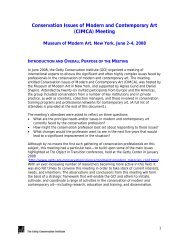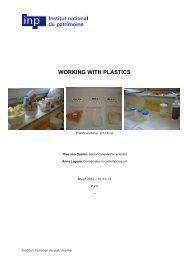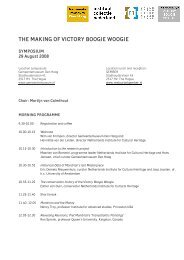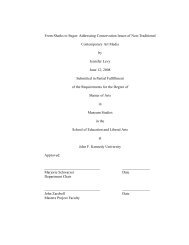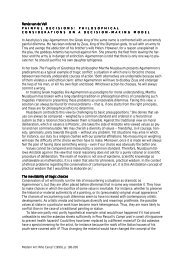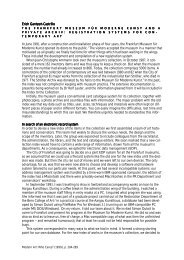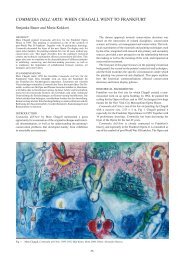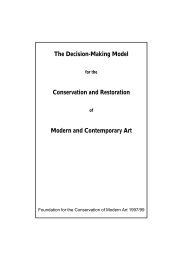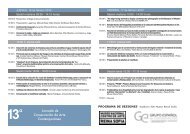Installations and problems of preservation.pdf - incca
Installations and problems of preservation.pdf - incca
Installations and problems of preservation.pdf - incca
You also want an ePaper? Increase the reach of your titles
YUMPU automatically turns print PDFs into web optimized ePapers that Google loves.
Questions <strong>of</strong> tempo<br />
poral<br />
rality<br />
Many installation works are not actually conceived in their entirety in advance but rely quite heavily<br />
on circumstances during the process. Artists <strong>of</strong>ten work directly <strong>and</strong> spontaneously on a work at<br />
the time <strong>of</strong> installation, allowing it to develop in response to a particular space or letting it evolve<br />
during its creation. Some artists are better than others at preconception. This can sometimes result<br />
in a work being unresolved or less than ‘perfect’ for an exhibition. If the work is purchased out <strong>of</strong> an<br />
exhibition, it is then frozen in this state – defined as an historical moment. The ambiguity <strong>of</strong> the<br />
artist may be reflected when the institution who purchased the piece attempts to contact the artist<br />
during a reinstallation <strong>and</strong> the artist wishes to conceive the work differently. This is not necessarily<br />
a problem, but if one <strong>of</strong> the museum’s goals is to preserve the integrity <strong>of</strong> the work it owns the<br />
question arises: can such works be mutable, or will each new conception be a new acquisition?<br />
What exactly, then, is being purchased when a museum acquires an installation? 2, 3<br />
The conservators’ role at the time <strong>of</strong> acquistion is to apply their knowledge <strong>of</strong> materials in order<br />
to fully document the installation. They should be able to anticipate certain materials issues <strong>and</strong><br />
technological requirements having an impact on the life span <strong>of</strong> the work.<br />
Many <strong>problems</strong> regarding the care <strong>of</strong> these art works are not yet resolved or may even be irresolvable.<br />
But hopefully raising the issues will assist other museums in underst<strong>and</strong>ing <strong>and</strong> interpreting<br />
their own works <strong>of</strong> a similar nature. The need for communicating experience <strong>and</strong> information is<br />
obvious, since many <strong>of</strong> us are confronted with exactly the same <strong>problems</strong> <strong>and</strong> are responding to<br />
them quite differently. If some form <strong>of</strong> network or exchange could be set up to record experiences<br />
with different artists’ work, it may save much unnecessary reinvention <strong>of</strong> the wheel. It would be useful<br />
to have an accessible record <strong>of</strong> curators <strong>and</strong> conservators who have had particular experiences<br />
with specific artists – as <strong>of</strong>ten occurs during the staging <strong>of</strong> an exhibition, when they may well be<br />
exposed to an overall sense <strong>of</strong> how an artist thinks <strong>and</strong> works. This might also save the artists from<br />
fielding phone calls by conservators who tend to ask the same questions repeatedly. A way to retain<br />
the information might be to include a short essay in exhibition catalogues on the artist’s intent <strong>and</strong><br />
the long-term <strong>preservation</strong> <strong>of</strong> the work (if applicable).<br />
Food for thought: some examples<br />
One <strong>of</strong> the earliest examples <strong>of</strong> installation art I traced was an intervention in the exhibition ‘First<br />
Papers <strong>of</strong> Surrealism’ in New York, held at the Whitelaw Reid mansion at 451 Madison Avenue in<br />
1942. André Breton was the organiser <strong>of</strong> this exhibition, for the benefit <strong>of</strong> the Coordinating Council<br />
<strong>of</strong> French Relief Societies. Breton asked Marcel Duchamp to come up with a provocative installation.<br />
Duchamp purchased 16 miles <strong>of</strong> string <strong>and</strong> proceeded to create a huge spider’s web throughout<br />
the exhibition space. This intervention, which made it very difficult to view some <strong>of</strong> the works,<br />
is cited as a metaphor for the prevalent opinion that the work <strong>of</strong> Surrealists was obscure <strong>and</strong> difficult<br />
to read.<br />
In addition to the string installation, Duchamp also created a ‘happening’ way before its time.<br />
He employed a group <strong>of</strong> youngsters dressed in athletic gear to play around <strong>and</strong> within the web.<br />
They were told to respond to any objections that “Mr Duchamp told us we could play here”. 4 This<br />
was a truly radical event at the time, <strong>and</strong> Duchamp did not even show up for it.<br />
I do not believe such an ‘installation’ was ever meant to be preserved. There is photographic documentation<br />
<strong>and</strong> it is recorded in historical texts. It may be that one day some curator decides to<br />
recreate it, but then it will not be a work <strong>of</strong> art – only an historical depiction. As far as I know the<br />
string no longer exists. Today, in our anxious attempt to preserve materials <strong>and</strong> record every event<br />
or creation, we would probably save something like this.<br />
It is a famous example, but undoubtedly there are numerous works <strong>of</strong> this kind throughout the<br />
twentieth century which could be categorised as installations <strong>and</strong> are now lost completely. Attempting<br />
to preserve every such work may be beyond the requisite responsibility <strong>of</strong> historians or conservators,<br />
falling into the fetish collection category. It can be very difficult, however, to distinguish<br />
between <strong>preservation</strong> <strong>and</strong> fetishisation when the inherent nature <strong>of</strong> institutions is to memorialise<br />
Modern Art: Who Cares? (1999), p. 272-281



